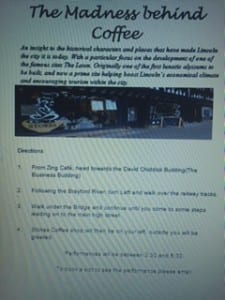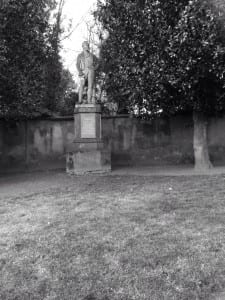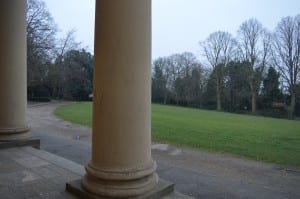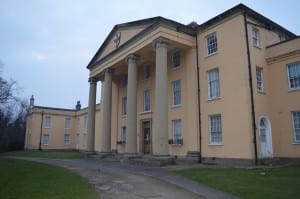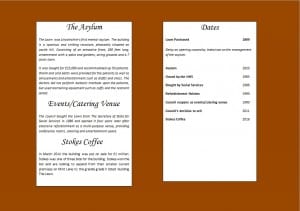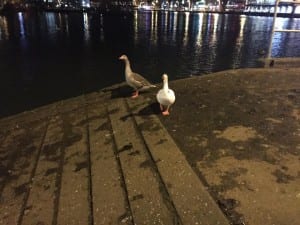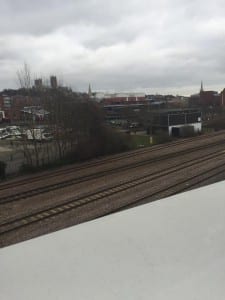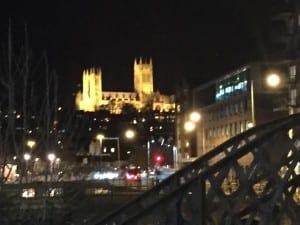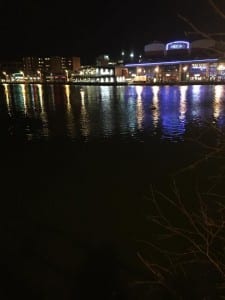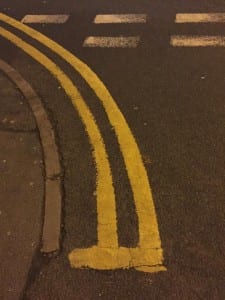The madness behind Coffee
The Madness behind Coffee performance situated at Stokes High Bridge Café in Lincoln. Each performance lasted about 15 minutes. In the café we had the space booked from 3pm to 5.30pm. To advertise the performance we made a poster which we posted on the university website. From the poster we had a few people interested, they contacted us and we arranged booking slots for them to come and participate in the piece.
We had four audience members come to see the show, we gave them each 30 minute slots as we wanted them to have a drink and not to feel rushed. We also gave time for them to sit and finish their drink if they wanted too. In the final performance my role was communicating with the manager of the coffee shop, setting up for the performance and performing in the piece. Marie Szalwinska stated that “These days, audiences expect more from site-specific theatre: the execution has to be as strong as the idea”. (Szalwinska, 2007) Due to our belief in Szalwinska’s ideals, we placed heavy emphasis on the need for rehearsals, ensuring our end performance clearly delivered on what we believe is a strong idea.
We started our performance by greeting the audience member and ordering them a drink of their choice, once they had their drink they were led upstairs and sat at a table. They were then given the headphones and advised to start the experience by beginning the playback. First to enter was the doctor. The doctor showed the side of The Lawn which he wanted people to see, he wanted the audience to know that The Lawn was a great place. “His methods were revolutionary – and unpopular – in his work to change the restraint methods employed by medical staff in the majority of mental hospitals”.(AA Ltd, 2015) The nurse then entered, she showed how The Lawn was for her to work in, followed by a patient who gave her experience of her time in the asylum. The audio then moved on to the council and how they were selling The Lawn and finally on to the future which a Stokes representative showed the future of The Lawn and what it will become. Our main influences for our performance came from the drift and going to the Lincoln Archive.
Process
We initiated the process by beginning a drift together in our pre-selected groups. A drift was a new experience for the rest of the group and I “You can drift anywhere. But to begin with, start somewhere you know well”. (Smith, 2015) We started at a common place, the LPAC building on Lincoln University campus. At every point a decision on direction was required, whether it be at a fork in the path or a junction in the road, one of the group would simply select where the group would go purely on impulse. “You don’t have to get anywhere, there is not a set destination. It’s all about the journey”. (Smith, 2015) The group really took this on board, enjoying the freedom such an unexperienced approach gave us. Continuing to let the drift take us anywhere in & around Lincoln, with no pre-selected destination or path all of us found new places in the city that we had not previously explored. As we walked around Lincoln we found a statue of Doctor Edward Parker Charlesworth.
On the statue was an explanation of who Dr Charlesworth was, why he has a statue and the work he did at a place called The Lawn. We carried on drifting, following the road and that’s when we came across a building. We decided to explore further and enter the grounds. As we entered we came across a sign which had further information about The Lawn, it explained that it used to be a mental asylum and gave us the initial dates we needed. After reading the sign we carried on walking around the grounds. It had an eerie feel, especially as the building was locked up and empty. We looked in some windows and it was clearly evident that it used to be a hospital. The grounds were surrounded by trees and there was lots of empty space which the public were using to walk dogs. In the corner was a children’s playground, exploring further it looked very old and seemed to be unused. Although the building’s interior was dated and gave us a sense of unease, the surrounding grounds were beautiful and gave us all instant ideas of what we could do. “By walking, you escape from the very idea of identity, the temptation to be someone, to have a name and a history … The freedom in walking lies in not being anyone; for the walking body has no history, it is just an eddy in the stream of immemorial life”. (Gros, 2014) The drift provided exactly the aforementioned escapism for our group. When we began our journey we had no preconceptions, destinations or ideas. Upon our return we had found a site that we wanted to build our piece around, and ideas that grabbed the imagination of us all. It was exciting and something different for each of us.
Ideas
Our first idea was to do a ghost walk of The Lawn and use researched stories of previous asylum patients, our intention being to deliver both an informative as well as an interesting piece. “There have been many reported sightings of ghostly figures, including those of children, roaming the corridors and grounds of The Lawn. They are said to wander round looking lost dressed in white robes”. (Phu, 2015) We began conducting online research, endeavouring to find more information about past patients. We prioritised the accuracy of our content. We quickly ascertained that, due to the lack of online information, we would need to find alternative sources. This led us to the Lincoln archive. “The experience was new to us and we found the process of the research exciting yet daunting as there were strict rules held in place whilst you were inside the Archive center due to the building holding factual and statistic information about the people of Lincoln and Lincoln itself”. (O’Sulivan, 2015) The archive helped us gain insight into The Lawn and how it worked in the 1800’s, which for the ghost walk helped us a great deal. As we wanted to make the ghost walk as authentic as possible, finding out how the doctors treated the patients and what the patients did on a daily basis created the story line of our ghost walk. “Johnny Gillett thoroughly researches the history of the site or the subject matter to be explored. This includes visits to libraries, records offices and even local people, as well as viewing the site itself several times. His hope is to gain a deeper understanding of the venue, tie this together with his own storytelling knowledge and so create a unique programme of tales to re-interprete the site”. (Gillett) In order to execute on authenticity, both extensive research and frequent location visits were undertaken by the group.
The archive was informative and told us much about The Lawn. Personally I found it very interesting looking at why some patients were admitted. Some stories that we found highlighted that misdiagnosis was rife in the 1800’s, often leading to admission for what I perceive to sometimes be simple cases of grief. The information gained from the archives meant we could now start the first draft of our script. We decided a script was the most effective way to do the recordings. When writing the script we started to plan the initial route for our performance. Starting at the tourist centre at the top of the hill and making our way round to the statue and The Lawn and going around grounds. Throughout the grounds we would be positioned, acting out the stories of the patients we had researched. As the idea developed we needed to find an ending. This meant more research to stimulate ideas.
We needed to find out about the reasoning behind The Lawn’s closure. We discovered The Lawn is being developed in to a coffee roastery. The more information we found out, led us to develop our second idea. This was to tell the tale of The Lawn, what it used to be, what it is now and what it could be in the future. Using the same concept as before and travelling around The Lawn premises we would help us achieve this. We were happy with our new idea but staying true to our ideal of factual accuracy, we needed to return to the information we gathered from the archive.
Having finalised the script we were ready to record however, we came across our first problem. The Lawn would be partly closed off due to refurbishment which meant we would not be able to use all our desired areas. This meant taking the piece in a different direction. We had a group meeting and discussed other possibilities. These were using part of The Lawn but we decided that the builders may be too loud for the audio. Next we thought about doing the piece at the statue but that again had it difficulties as it was such a small space to perform. Anya then suggested performing the piece in stokes coffee shop. “Practitioner Peter Brook famously announced that ‘I can take any empty space and call it a bare stage’ (Brook 1972:11). Brook was interested in work that might take place beyond the conventions of the proscenium arch theatre and looked to experiment with different performance sites”. (Govan). Govan influenced me to work with Anya’s idea as adapting the script and performing in a coffee shop excited me. Once we decided this was the best option we worked hard to catch up on the time we had lost. When re-visiting our research, we found a previously unused letter and when re reading it, discovered it gave invaluable insight into what a patient’s life in the asylum was like. We all believed the letter would help the audience member to better engage with the feeling of The Lawn. We then decided that my character the nurse should give the letter as the nurses had to deal with patients. “In addition to Anya’s information from her previous post we also found questions within the register which were asked to relatives/friends of the admitted patient. These questions excited us as we believe we can use them on our audience so they have a real sense of what it was like to be a part of the asylum”.(O’Sulivan, 2015) My character the nurse had to deliver both these bits of information in my audio monologue.
Recording
After finalising the script we started recording. Using the recording device I found this to be fairly easy. We did some testing to see where it was best to record for a clear sound. We found that to get the sound we wanted we needed to find a space with no noise or echo, for this we used corridors in the Lpac. We would leave 10 seconds either side of the recording to be able to play with the record on audacity and we also did at least two recordings. Once we did the recording we put them on to audacity and started to edit and arrange them in to an order. To make the audio sound natural, we needed to have background noises.
As well as recording we had props to prepare. Firstly we started with a newspaper. We did not want to risk audience engagement through an overload of facts, dates and/or information through the audio. We therefore came up with the idea of a newspaper prop, this would help deliver the aforementioned information through a different medium, adding diversity of content delivery. However, when reviewing the newspaper with Karen, it was decided, as a prop, it was not fit for purpose as there was too much content. We subsequently shifted to the idea of a mood board. This would have key facts and dates but also provide visual stimulation for the audience member in the form of pictures. We sourced cork boards, making them into the mood boards. They looked effective, but we felt that they did not fit in to the piece as they were large and would not make sense in the context of the scene. Finally we decided on a table style menu, this had key dates, actors, facts and a little information about The Lawn. We did the menu in the style of the Stokes café so it would fit in with the décor. The menu worked well as it was brief, but concise, delivering the exact content desired.
On the day
On the day of the performance we met early in the morning to go over last minute issues and do a full practice run. We started by preparing a timeline for the day, intending this to drive productivity. We then printed off our paper props. These were a menu in the style of stokes, a letter which we had found at the archive and a poster for the audience member as it had directions to the site. Once we did this we split the group in half, Alex and Sam went to finalise the audio and give the poster to the audience members. Anya, Ellie and I went to get a few last minute props, these were a note pad, pen and envelopes. Once we had all returned we got changed into our costumes to perform a dress run. We had to use Sam to listen to the audio while we performed and then I swapped with Sam just before his part. This was hard to know if the piece flowed as we had to swap throughout people’s monologues. Once we were happy we decided to make our way over to the coffee shop and start to set up.

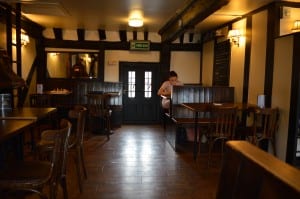 (Robinson, 2015) Fig 6,7.(Bullock, 2015) Fig 3.
(Robinson, 2015) Fig 6,7.(Bullock, 2015) Fig 3.
Our set was minimal as we used the features of the shop. We set up our audio device, where we were going to be based during the performance and any props that we needed to use during the piece. Once we were set up we waited for our first audience member. Four audience members were booked and each had a half an hour slot, this gave enough time for a hot drink, and preparation with the audio device we then also left enough time for them to sit and finish their coffee. There was the option to take it away also.
Performing
Each performance went differently. The first one for me went well but I was nervous and I made silly mistakes. Going in to the next performance I felt more comfortable and really got in to the performance actions. Each performance provided more confidence and, I believe, a subsequent improvement. During the last performance, the audience dropped cake on the floor and laughed which I found hard not to laugh as well.
Performance Evaluation
The final performance I felt went really well, although there were difficulties and things which did not go entirely as we had practiced. However, with improvisation we managed to create and perform a great piece. It was a different experience performing in a coffee shop, as it was not a typical location. It worked well for us as we wanted to give a coffee shop experience which we feel was delivered. Performing in a coffee shop was a non-traditional place to perform, I liked this and after performing in a different location I am intrigued to work more on pieces like this. The alternative location gave the performance a different feel for each audience member, dependant on how they engaged with the script, scene, props and performers. I am very keen to develop further on The Madness behind Coffee.
Throughout the process I thought we worked well as a group, this was continually a strength and the results would not have been the same without this synergy. The members of the group complimented each other as Alex and Sam knew quite a lot about using audacity so they naturally did a lot more of the editing. The creativity we all brought was a strength as we all had so many ideas that we wanted to do which gave us and ended in the performance we gave. The communication within the group was good which it needed to be.
Sometimes throughout the process certain members could be difficult to work with. As we had so many ideas they could be conflicting and not work, we did however try to work through every idea people had to try and see if we could incorporate them within the performance. Another difficulty we had was when we finished our timetabled lessons we all had difficult availabilities so there would be weeks where the whole group could not meet up which meant we did not always get as much work done as we would like. Another weakness we had was timing, we had no clear way to time our monologues. As we could not hear the audio it was hard to gage where were within the script. Alex had a watch which he incorporated into his costume and made work for him. Anya performed her part outside so she had her phone timer. Sam used his tablet which he made part of his performance however for me and Ellie there was no simple way to have a timer as I was from the past and Ellie was a patient and she would not have been allowed any jewellery.
Improvements
There was a few things I would improve from the final performance which was to find a better system of timing the monologue so is not as obvious and we don’t have to count in our heads. I would want to work on the interaction with the audience as some member actually spoke and answered questions asked on the audio which I found interesting and I did not expect to happen. I thought this really worked and felt the piece could have had more of this if the audience member wanted to. With more interaction I felt we could have done more with our performances, for example I could have done more nurse actions.
Ideas
From the performance I had new ideas form during the performance and after. Some ideas that I had were to extend the script and the make the performance longer, partially focusing on The Lawn as I think that could be extended and more. I also think that the characters should not just have one monologue and go they should come in out during the performance. The only problem I see with this is the timing.
Words 3142
Citation List
A A Ltd. (2015) Edward Parker Charlesworth. Available from: http://www.itsaboutlincoln.co.uk/e-charlesworth.html [Accessed 14 May 2015]
Bullock, L. (2015) [Photograph]
Bullock, L; Fitzgerald, A; Marshall, A; O’Sullivan, E; Robinson, S. (2015) The Madness Behind Coffee. [Performance] Lincoln: Stokes Coffee Shop, 7 May.
Fitzgerald, A. (2015) [Photography]
Gillett, J. Site Specific Stories. [Online] Available from: http://www.thejourneyman.org.uk/site-specific-stories.html [Accessed 14 May 2015]
Govan, M. The Place of the Artist.
Gros, F. (2014) A Philosophy of Walking. London: Verso.
O’Sulivan, E. (2015) Lincoln Archive Centre- The Lawn Research. [Blog Entry] 5 February. Available From https://sitespecific2015ksa.blogs.lincoln.ac.uk/2015/02/05/lincoln-archive-centre-the-lawn-research-ellie-osullivan/ [Accessed 14 May 2015]
Phu. (2015) Haunted History of Lincoln. Available from: https://hauntedhistoryoflincolnshire.blogs.lincoln.ac.uk/lincoln/the-lawn/ [Accessed 14 May 2015]
Robinson, S. (2015) [Photograph]
Smith, P. (2015) A Starter Kit for Drifters.
Szalwinska, M. (2007) Site Specific work is just about location, location, location. The Guardian, 26 April.
